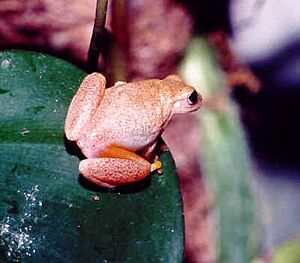San Carlos treefrog facts for kids
Quick facts for kids San Carlos treefrog |
|
|---|---|
 |
|
| Conservation status | |
| Scientific classification | |
| Synonyms | |
|
Hyla phlebodes Stejneger, 1906 |
The San Carlos treefrog (Dendropsophus phlebodes) is a small type of frog. It is also known as the San Carlos dwarf treefrog. This frog belongs to the Hylidae family, which are often called treefrogs. You can find it in countries like western Colombia, Costa Rica, Nicaragua, and Panama.
These frogs usually live in warm, wet lowland forests. However, they can also live in areas where humans have changed the land. Sadly, their homes are shrinking because of habitat loss.
Contents
About the San Carlos Treefrog
The San Carlos treefrog is a small but strong frog. Female frogs can grow to about 28 millimeters (just over an inch) long from their nose to their bottom. Males are a little smaller.
This frog has a rounded nose and a wide head. Its eardrum, called the tympanum, is partly hidden by a fold of skin. Males have a single vocal sac in their throat. This sac helps them make loud calls.
Their front legs are short. Their long, thin fingers have flat, wide pads at the tips. These pads help them grip surfaces. The back legs are short but strong. Their long toes are partly webbed and also have wide tips.
The skin on their back is smooth and light brown. It might have some slightly darker patterns. Their belly is bumpy and white. This color changes to cream and yellow on the inside of their thighs. Their eyes have a yellowish-bronze color. During the time they reproduce, the male's vocal sac turns yellow.
Sometimes, the San Carlos treefrog can be mistaken for other frogs in its group. For example, the Dendropsophus ebraccatus has a special hourglass shape on its back. The San Carlos treefrog does not have this pattern. Also, the calls of the San Carlos treefrog are shorter.
Where San Carlos Treefrogs Live
The San Carlos treefrog is a nocturnal animal, meaning it is active at night. It lives in low-lying areas. You can find it in the Pacific northwestern parts of Colombia (in the Chocó and Risaralda regions) and Panama. It also lives on the Atlantic side of Panama, Costa Rica, and Nicaragua.
Its natural home is in humid forests. These frogs lay their eggs in shallow pools of water. They usually do not live higher than 700 meters (about 2,300 feet) above sea level. You might also find them in farm fields, wet meadows, and even drainage ditches.
What San Carlos Treefrogs Eat and How They Reproduce
The San Carlos treefrog is a generalist predator. This means it eats many different kinds of small animals. It hunts small creatures that live on the ground. These include spiders, and the young forms of moths and flyes.
These frogs are "explosive breeders." This means they reproduce very quickly when the rainy season begins. Heavy rain makes the male frogs gather together. They call out from low plants near temporary pools or flooded fields. Many males might call at the same time. In Panama, they often join other frog species, like Dendropsophus microcephalus and Dendropsophus ebraccatus, in a big chorus.
Female frogs lay their eggs in groups of about four hundred. They place these egg clusters among plants that are growing in shallow water.
Status of the San Carlos Treefrog
The San Carlos treefrog is listed as a species of "least concern" by the IUCN Red List of Threatened Species. This means that experts believe its population is stable. It is common across a wide area and can adapt to different places.
The biggest danger to these frogs might be pollution in the water where they lay their eggs.


